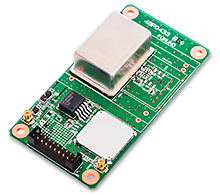Articles for ITS market Japanese automakers' carbon-neutral strategies swept up in ESG investment
Honda's realization in 2040
The carbon-neutral strategies of Japanese automakers are lagging behind those of their overseas counterparts. This is the impression given by statements from senior executives at the president's press conferences and financial results announcements of Japanese automakers in April and May 2021.
In recent events, first, Honda announced its future business reforms on April 23, 2021, during the inaugural press conference of President Toshihiro Mibe. “Honda will increase the sales ratio of EVs (electric vehicles) and FCVs (fuel cell vehicles) to 100% globally by 2040.”
The sales ratio will be increased gradually from 40% in 2030, nine years from now (2021), to 80% in 2035.
Regarding 2040 as the target year, President Mibe said, “Many countries and regions around the world are aiming to become carbon neutral by 2050, including the Japanese government. We set the target for 2040, 10 years earlier than 2050, based on the assumption that the replacement demand for new vehicles will last about 10 years.”
With this announcement, one gets the impression that Honda is the most aggressive of the Japanese manufacturers in shifting to electrification at this point (May 2021).
However, looking back some time ago, Honda was not the manufacturer that emphasized the shift to EVs and FCVs, although it was active in promoting hybrid vehicles in Japan.
For example, when Honda introduced the Fit EV in the U.S. in the 2010s, the company's president at the time, Takanobu Ito, stated that “the ZEV law is the only thing that matters” and that “it will be difficult to spread EVs and FCVs for the time being if we rely on regulations and subsidies.” The ZEV Act refers to the zero-emission vehicle regulation law enacted by the State of California.
Later, Honda also conducted demonstration tests of the Fit EV in response to the Chinese government's electric vehicle policy in Guangzhou and other cities where Honda has a production plant. But Honda executives at the time positioned this as "just a means to maintain relations with local government regulations in mind.”
As for FCVs, when the Japanese government launched the "First Year of a Hydrogen Society" in 2015 to popularize ENE—FARM (Energy farm) for home use and FCVs, the "FCX Clarity" was mass-produced following the Toyota "MIRAI".
However, by the latter half of the 2010s, the number of FCX Clarity leases sold was extremely low, and Honda was no longer interested to launch its own promotion to expand the use of FCVs.
In October 2020, Honda announced that it officially withdrew from Formula One and that it would drastically review its internal development system to become carbon neutral, setting the stage for the current "100% EV/FCV by 2040."
 A view of Nissan's financial report. Source: Nissan
A view of Nissan's financial report. Source: Nissan
 The hydrogen engine being developed by Toyota. Source: Toyota
The hydrogen engine being developed by Toyota. Source: Toyota
 Toyota's hydrogen engine development will also be carried out using racing cars. Source: Toyota
Toyota's hydrogen engine development will also be carried out using racing cars. Source: Toyota
Strategies of Nissan and Toyota
Next is Nissan. Nissan mentioned the mass production of e-POWER EVs and series hybrid vehicles globally from 2021 in its financial report on May 11, 2021.
In the report, the company said that e-POWER will be introduced in X-trail and Qashqai to support CAFE (Corporate Average Fuel Economy) in Europe.
With regard to EVs, Nissan is already producing many models in response to the NEV (New Energy Vehicle) regulations in China, and the company is strengthening its stance to promote the ARIYA as a global strategic EV from 2021.
Makoto Uchida, CEO of Nissan, insists on the strength of Nissan's EV strategy. "We will make use of our EV development know-how accumulated by Leaf over the past 10 years.
However, he refrained from answering questions about FCVs and the development of hydrogen-powered engines. He instead emphasized the importance of optimizing Nissan's business in the Renault-Nissan-Mitsubishi Alliance to "put a high priority on returning to profitability," given the fact that the company's financials are still in significant deficit.
On the other hand, when Toyota announced its financial results on May 12, 2021, its plan to carbon neutrality was also presented.
In the report, the company stated that it would aim for carbon neutrality in 2050, and sell a total of 2 million EVs and FCVs out of 8 million electric vehicles, including hybrids, globally in 2030.
This is a high target, about twice as high as the future projection for the spread of electric vehicles, which was revised in 2017 and 2019.
Before the press conference, the company also announced that it would use internal combustion engines such as gasoline vehicles to accelerate the development of E-FUEL, a synthetic fuel that uses hydrogen, and hydrogen engines that use hydrogen itself as fuel.
The Game Changer of ESG Investment
These manufacturers' aggressive investments in the shift to electrification and the intensified development of various next-generation fuels are certainly moves that take carbon neutrality into account.
However, through my interviews with various parties, I have the impression that the rapid changes in the world regarding carbon neutrality were not expected by the manufacturers, and that they are desperately trying to catch up with these movements.
In other words, the industry and manufacturers themselves have the impression that the Japanese automobile manufacturers are lagging behind the changing times.
The Ministry of Economy, Trade and Industry (METI) defines ESG investment as "investment that prioritizes environmental, social, and governance factors in addition to traditional financial performance.
The concept of evaluating the sustainability of corporate management has become widespread, especially among institutional investors who manage large assets such as corporate pension funds over the long term. In addition, as a benchmark for long-term risk management (ex. climate change) and new revenue opportunities assessment, the UN Sustainable Development Goals (SDGs) has been in the spotlight.
In the past few years, there has been a common theme that the automotive industry is facing a "once-in-a-century revolution" due to the simultaneous development of various technological innovations such as CASE (connected, automated driving, new services such as sharing, and electrification) and MaaS (mobility-as-a-service).
Therefore, developers inevitably tend to be more interested in IT-based-connected and automated driving.
On the other hand, with regard to fuel efficiency and CO2 reduction, we have drawn a roadmap for the gradual electrification of powertrains based on the efficiency improvement of internal combustion engines, in response to the European CO2 regulation, the US ZEV law, and China's NEV regulation.
However, the impact of ESG investment has expanded rapidly on a global scale. The "Green Strategy" formulated by the Japanese government in December 2020 has become a policy with "ESG investment" oriented.
With the emergence of the new game changer of ESG investment, Japanese automakers are required to shift towards the new era.
Writer introduction

Mr. Kenji Momota Automotive journalist
His major is the world automotive industry and he is also familiar with the energy industry, IT and the aging society problem as the related fields. He acts around the world based in Japan and USA and writes for the general magazines, the technology journals and the automotive related media etc.
He is also commentator of motor race and world's motor show on TV program based on his career of the driver of Indy Racing League and NASCAR. In recent years, he has been covering about a paradigm shift from developed countries to developing countries, the motorized vehicle like EV and the telematics.
FURUNO ITS Journal
Click here for the latest articles after 2022 (in Japanese)2022
- The "realistic" self-driving roadmap shown by the Japanese government and a hands-on report on the latest Subaru EyeSight X
- Will FCVs (Fuel Cell Vehicles) Become Popular? ~New Movement in Toyota and Honda~
- The 'Complete' online sales of new cars start in Japan. Will this new way of buying cars take root?
- Many Firsts! On-Site Report from Tokyo Auto Salon 2022 - The author, who knows what goes on behind the scenes, looks back on 40 years of history. -
2021
- "Moving toward zero traffic fatalities for four-wheeled and two-wheeled vehicles globally in 2050" ~Experience on Honda's latest safety technologies~
- Tsuneishi Shipbuilding's building and DX, an exclusive visit to the main factory
- Japan's Smart City: New Moves toward Practical Use
- When will self-driving buses (service cars) be put to "full-scale" practical use?
- Utilization vehicle data during disasters
- Toyota-led Connected Technology to Transform Commercial Vehicle Business -From light trucks to large trucks and buses-
- Toyota enters the connected car "Personalization" business
- Japanese automakers' carbon-neutral strategies swept up in ESG investment
- Drive experience of the latest autonomous vehicle models and advanced driving support systems
- Will carbon neutrality accelerate the trend to strengthen LCA (Life Cycle Assessment)?
- Semiconductor shortage exposes realities of the automotive industry
- Online Autonomous Driving Contest Enhancing development of Human Resources
2020
- What happens to CASE when gas cars are banned in Japan?
- When will Flying Cars be launched?
- Expectation vs. reality:Autonomous Driving in Japan
- V2X, Becoming increasingly important in autonomous driving
- Technology of Subaru “EyeSight X”
- Lifestyle-oriented French cars gain popularity in Japan
- Human-oriented smart cities are wanted
- MaaS and CASE, how would automotive industry change after COVID-19?
- The beginning of virtualization era, triggered by COVID-19
- Trend of EV shift and consumer demands
- TOYOTA Press conference about ADAS - Releasing algorithm for "sudden acceleration suppression during attempted sudden acceleration" free of charge -
- The Japanese automotive industry in 2020 - 3 turning points -
- "Using a smartphone while driving" and "Level 3 automated driving"
2019
- Motor show business model is at a turning point - Tokyo Motor Show Report -
- Commercialization and monetization of MaaS - ITS World Congress Singapore Report -
- Android Automotive pays attention to V2X - Report from the Frankfurt Motor Show 2019 in Germany -
- Automobile Distribution Revolution and DCM (Data Communication Module)
- Connected business potential and newly proposed "eMaaS" by Honda
- 5G services for practical use are multiplying
- Connectivity technologies attracting attention due to frequent traffic accidents
- Shanghai Motor Show report -SUV, EV, Automated car & 5G-
- Drone Business roadmap and updates to Michibiki (Quasi-Zenith Satellite System)
- MaaS (Mobility as a Service) "town development." Full-scale promotion for a national project
- CES organizer states "Data Period in 2020s." Transformation of the Automotive Industry in CES, US "-CES2019 Report-"
- "Return to Origin" directed towards the age of change, automatic operation and connectivity
2018
- New proposal for Private Car Automated Driving Level and other Hot 5G Technology Topics
- Standardized EV charging infrastructure concerns in Europe, US, Japan and China - Kobe EVS 31 field report -
- Touring a pure car carrier and a test drive of the latest hybrid car
- Planning stage products are exhibited at the newly established visualized mobility service "TOYOTA MOBILITY SHOWROOM".
- Potential “Community Car-share” program promoted by local residents
- CES Asia Report 2108
- Companies attempt new Vehicle-to-Infrastructure communications, including traffic volume measurements and vehicle positioning. -ITS Asia Pacific Forum in Fukuoka-
- Geneva show in Switzerland. Flying cars and MaaS (Mobility as a Service) were hot topics.
- EV (Electric Vehicle) proposals by country
- MaaS competition through service mobilization, M & A and technical field collaboration is accelerating. - The CES 2018 Report -
2017
- Big data’s initiative and fight for the automotive industry. Cooperation among companies becomes increasingly important.
- Connected car and road-to-vehicle communication automatic operation
- ETC (Electronic Toll Collection) and ETC2.0. Current situation and projected future
- Rapid development of sharing economy
- Germany is first to recognize level 3 automated driving
- ITS EU 2017 Field Reports -Automatic Operation and the eCall-
- From Infotainment to ITS, the competitive area is spreading in the car big data industry.
- GTC (GPU Technology Conference) Report and the de facto standardization of AI (artificial intelligence)
- Renesas' new challenge! "e-AI Solution" and "Renesas Autonomy"
- The Automobile industry is shifting from a manufacturing industry to a service industry.
- The movement toward accident countermeasures for aging drivers in Japan
- Fusion of ride sharing and fully automated driving is advancing in the USA.
2016
- Overview of the Quasi-Zenith Satellite System (QZSS) and advancements toward full-scale practical use including the Tokyo Olympic Games - G-space EXPO 2016 report-
- Japan’s automated driving project "SIP-adus" will be a large demonstration experiment.
- The International Home Care & Rehabilitation Exhibition. There were many car manufactures with exhibits booths at this show.
- Japanese car manufacturers starting to concentrate on strengthening the ADAS system
- A new movement of legislation for autonomous cars
- Cyber Security and “AGL”, the new OS for automotive are hot topics in the connected car industry
- “High precision 3D map” the key future of autonomous car and pedestrian dead reckoning
- Chinese “BAT” is accelerating their business in the EV (Electric Vehicle) market
- Tesla's original connection to Taiwan and the new transportation system technologies.
- "The main topic" of the Geneva Motor Show was how to strengthen "pedestrian protection"
- The probe data business is getting more competitive
- Reporting directly from the 2016 CES show "Data services will soon become the main revenue source of automotive industry"
2015
- Do the automated driving systems need the GNSS (Global Navigation Satellite System) ?
- ETC Version 2.0 is coming soon. A new service was announced at the Tokyo Motor Show and the possibility that is could be used as a device for older drivers.
- "Connected Horizon" and "eHorizon". Germany's leading parts supplier accelerates strengthening of "Big Data" for business



 Figure showing the global EV/FCV sales ratio by 2030, 2035, and 2040, as announced by Honda. Source: Honda
Figure showing the global EV/FCV sales ratio by 2030, 2035, and 2040, as announced by Honda. Source: Honda GPS/GNSS Receiver&Chips and Modules (positioning and timing)
GPS/GNSS Receiver&Chips and Modules (positioning and timing)